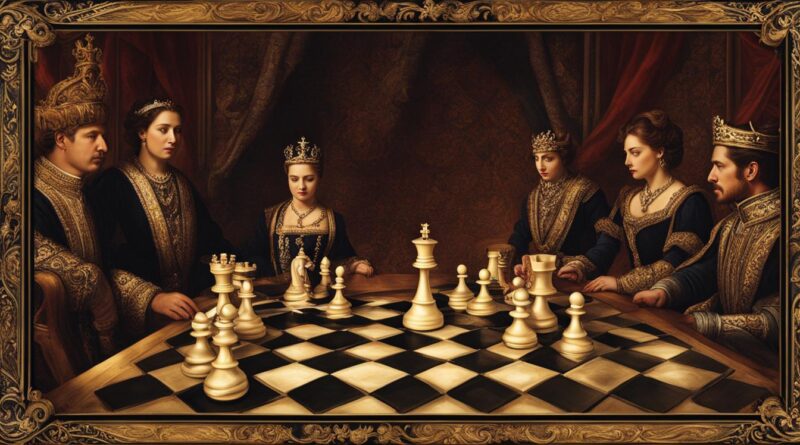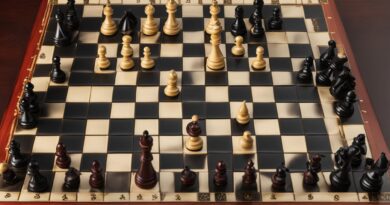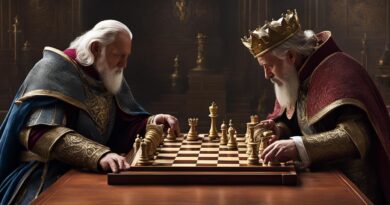Queen and Pawns vs. King and Queen in Chess: Strategies and Tactics for this Endgame
In the game of chess, the endgame of Queen and Pawns vs. King and Queen is a fascinating and challenging one. This particular endgame requires careful strategies and tactical moves to secure victory. Chess experts have extensively studied this endgame, analyzing various positions and developing winning strategies.
Key Takeaways:
- Queen and Pawns vs. King and Queen in chess is a complex endgame that requires strategic thinking.
- Exchange of queens through cross-checks is often crucial to gain an advantage.
- The defending king’s position plays a crucial role in determining the outcome of the game.
- The rook, knight, bishop, and central pawns have different winning chances.
- Studying examples from games can provide valuable insights into playing this endgame effectively.
A Brief History of the Queen and Pawns vs. King and Queen Endgame
The Queen and Pawns vs. King and Queen endgame has a rich history of analysis and study. Early analysis in the 1940s and 1950s focused on superficial examination of positions from the time of Philidor. However, it wasn’t until the 1950s and 1960s that this endgame gained more attention, thanks to the contributions of theorists like Yuri Averbakh.
Comprehensive analysis and understanding of this complex endgame became possible with the advent of endgame tablebases. These powerful computerized databases allowed for the exploration of countless positions and revealed that more positions can be won than previously thought.
The analysis of the Queen and Pawns vs. King and Queen endgame has provided valuable insights into winning strategies and tactics. It has shown that the position of the defending king plays a crucial role, and different pawn configurations offer varying winning chances. The ongoing analysis and study of this endgame continue to deepen our understanding of its complexities and improve players’ skills in navigating it.
| Year | Development |
|---|---|
| 1940s-1950s | Superficial analysis based on Philidor’s positions |
| 1950s-1960s | Contributions of theorists like Yuri Averbakh |
| Present | Comprehensive analysis with endgame tablebases |
General Considerations in the Queen and Pawns vs. King and Queen Endgame
The Queen and Pawns vs. King and Queen endgame is a complex battle where the defending king plays a crucial role. Understanding the general considerations can help players devise effective strategies and increase their winning chances in this challenging endgame.
According to Reuben Fine and Pal Benko, the game is typically a draw unless the pawn is a bishop pawn or a central pawn, and the defending king is positioned in front of the pawn. However, Karsten Müller and Frank Lamprecht have different criteria, stating that the defending king needs to be in front of the pawn for a draw. In either case, the position of the defending king is essential in determining the outcome of the endgame.
Different pawn configurations also affect the winning chances. The rook pawn is the most common pawn in this endgame, offering decent winning chances when it reaches at least the sixth rank. On the other hand, the knight pawn provides better winning chances than the rook pawn when it advances to at least the fifth rank. The bishop pawn offers the best winning chances, even if the defending king is far away from the pawn. The central pawn also presents favorable winning chances, especially when the defending king is not in front of the pawn.
Rook Pawn in the Queen and Pawns vs. King and Queen Endgame
The rook pawn is one of the most common pawns in the Queen and Pawns vs. King and Queen endgame. Its position and characteristics play a crucial role in determining the winning chances or draw positions in this endgame scenario. When the rook pawn reaches at least the sixth rank, it offers decent winning chances for the attacking side.
According to the guidelines provided by Mednis, certain draw positions can be achieved with a rook pawn. However, it’s important to note that in practice, drawing with a rook pawn can be challenging. The outcome heavily relies on the defending king’s position and accurate play from both sides.
To provide a comprehensive analysis of the rook pawn in this endgame, the following table showcases key positions and outcomes:
| Position | Attacking Side | Defending Side | Result |
|---|---|---|---|
| 1 | Rook pawn on the 6th rank | Defending king in front of the pawn | Win for the attacking side |
| 2 | Rook pawn on the 6th rank | Defending king not in front of the pawn | Challenging but favorable winning chances for the attacking side |
| 3 | Rook pawn on the 7th rank | Defending king in front of the pawn | Win for the attacking side |
| 4 | Rook pawn on the 7th rank | Defending king not in front of the pawn | Significant winning chances for the attacking side |
As the table demonstrates, the position of the rook pawn and the defending king greatly influence the outcome of the game. Players must be mindful of these factors when strategizing and executing their moves in the Queen and Pawns vs. King and Queen endgame.
Knight Pawn in the Queen and Pawns vs. King and Queen Endgame
The knight pawn in the Queen and Pawns vs. King and Queen endgame offers better winning chances compared to the rook pawn. To achieve a favorable outcome, it is crucial for the defending king to be in front of the pawn or in the corner opposite its promotion square. This positioning restricts the defending king’s ability to counterattack and increases the attacking side’s chances of winning. The exchange of queens is also less likely to result in a drawn king and pawn versus king endgame, further favoring the attacking side.
As shown in the table below, the defending king’s position significantly impacts the outcome of the game when facing a knight pawn. The centralization of the defending king, denoted by “CK in Front,” provides the best chances for a draw. Meanwhile, positions where the defending king is not in front of the pawn, labeled as “CK Not in Front,” tend to favor the attacking side. This highlights the importance of strategic king placement in the endgame.
| Defending King’s Position | Result |
|---|---|
| CK in Front | Draw |
| CK Not in Front | Attacking Side’s advantage |
By understanding the winning chances associated with the knight pawn and the significance of the defending king’s position, players can develop effective strategies to navigate the Queen and Pawns vs. King and Queen endgame. It is essential to consider the unique characteristics of each pawn type and adapt gameplay accordingly to secure a favorable outcome.
Bishop Pawn in the Queen and Pawns vs. King and Queen Endgame
In the Queen and Pawns vs. King and Queen endgame, the bishop pawn offers the best winning chances. It can win even when the defending king is far away from the pawn. The location and position of the defending king play a crucial role in determining the outcome of the game.
To illustrate the winning chances of the bishop pawn, let’s examine a specific scenario:
In a position like the one shown above, where the opposing king is far away from the pawn, the attacking side has a significant advantage. The bishop pawn’s diagonal movement allows it to secure a promotion, and the defending king’s distance becomes a disadvantage. It becomes difficult for the defending side to prevent the pawn from queening.
Table: Winning Chances with Bishop Pawn
| Defending King Position | Winning Chances |
|---|---|
| In front of the pawn | Draw |
| Away from the pawn | Attacking side has better chances of winning |
The table above summarizes the winning chances with a bishop pawn. If the defending king is in front of the pawn, a draw is the most likely result. However, if the defending king is away from the pawn, the attacking side has better chances of winning due to the bishop pawn’s ability to create threats and promote to a queen.
Understanding the dynamics of the bishop pawn in the Queen and Pawns vs. King and Queen endgame is essential for chess players looking to maximize their winning chances. By recognizing the importance of the defending king’s position and leveraging the strengths of the bishop pawn, players can make strategic decisions that tilt the game in their favor.
Central Pawn in the Queen and Pawns vs. King and Queen Endgame
The central pawn in the Queen and Pawns vs. King and Queen endgame plays a crucial role in determining the winning chances for the attacking side. Unlike the rook and knight pawns, the central pawn offers better winning chances, especially when the defending king is not in front of the pawn. In such cases, the attacking side has a favorable opportunity to push the pawn forward and create winning threats.
However, the defending king’s position remains a critical factor in determining the outcome of the game. If the defending king manages to position itself in front of the central pawn, it can often secure a draw by creating a blockade and preventing the pawn’s promotion. Therefore, the attacking side needs to carefully maneuver its pieces to restrict the defending king’s movement and maintain control over the central pawn.
To illustrate the significance of the central pawn in the endgame, let’s take a look at the following table that showcases the winning chances based on the position of the defending king:
| Defending King’s Position | Winning Chances for Attacking Side |
|---|---|
| In front of the pawn | Diminished winning chances |
| Not in front of the pawn | Favorable winning chances |
As the table indicates, if the defending king is not in front of the central pawn, the attacking side enjoys better prospects of winning. This emphasizes the importance of strategic placement and control of the central pawn to exploit the defending king’s vulnerability. Players should aim to position their pieces in a way that maximizes the winning chances for the attacking side and minimizes the defensive options for the opposing king.
By understanding the dynamics of the central pawn in the Queen and Pawns vs. King and Queen endgame, players can develop effective strategies to capitalize on this advantageous position and increase their chances of achieving victory.
Examples from Games in the Queen and Pawns vs. King and Queen Endgame
Studying examples from actual games can provide valuable insights into the strategies and tactics of the Queen and Pawns vs. King and Queen endgame. These examples showcase different winning plans, draw positions, and exceptions to the general rules, allowing players to enhance their understanding and improve their skills in playing this complex endgame.
In the following table, we present three notable examples that highlight various aspects of the Queen and Pawns vs. King and Queen endgame:
| Game | Description | Key Takeaways |
|---|---|---|
| Example 1 | In this game, White successfully utilizes a breakthrough to create a passed pawn and secure a decisive advantage. The defending Black king is unable to prevent the promotion, leading to a victory for White. | Breakthrough techniques can be powerful in creating winning opportunities. It is crucial to accurately assess the potential of passed pawns and optimize their chances of promotion. |
| Example 2 | This game demonstrates a well-executed king march by the defending side, effectively neutralizing any winning chances for the attacking player. Ultimately, the game ends in a draw due to the defensive efforts of the defender. | Proper king positioning and defensive maneuvers can successfully hold off the attacking side, resulting in a draw even in position with winning potential. |
| Example 3 | In this example, both players engage in a series of tactical maneuvers, constantly testing each other. The game eventually reaches a draw through perpetual checks, highlighting the importance of accurate calculation and tactical awareness. | Sharp tactical play can create opportunities for perpetual checks, forcing a draw even in seemingly winning positions. Being alert to the opponent’s tactical possibilities is crucial. |
These examples provide a glimpse into the complexities of the Queen and Pawns vs. King and Queen endgame. By studying and analyzing such games, players can gain valuable insights into the various strategies, tactics, and patterns that can arise in this endgame scenario. It is essential to develop a deep understanding of the principles and apply them in practical play, adjusting to the specific circumstances of each game.
By constantly reviewing and learning from examples like the ones presented above, players can enhance their decision-making abilities and improve their performance in the Queen and Pawns vs. King and Queen endgame. It is through a combination of study, practice, and experience that players can develop the necessary skills to navigate this complex endgame successfully.
Traps in the Queen and Pawns vs. King and Queen Endgame
As players navigate the intricate Queen and Pawns vs. King and Queen endgame, it is essential to be mindful of traps that can arise, particularly when dealing with a bishop pawn. These traps can catch even the most experienced players off guard and dramatically impact the outcome of the game.
The specific positions where these traps tend to emerge can be challenging, especially when the attacking king is not in close proximity to force a win. The nature of the bishop pawn adds an extra layer of complexity, requiring players to exercise caution and strategic thinking.
By remaining vigilant and aware of these potential pitfalls, players can avoid falling into these traps and secure favorable outcomes in the Queen and Pawns vs. King and Queen endgame. It is crucial to study and analyze these positions thoroughly, ensuring a comprehensive understanding of the potential traps and how to navigate them effectively.
FAQ
What is the endgame of Queen and Pawns vs. King and Queen in chess?
The endgame of Queen and Pawns vs. King and Queen is a complex and challenging one, often involving cross-checks to force the exchange of queens. It can be a draw if the defending king is in front of the pawn.
How common is the Queen and Pawns vs. King and Queen endgame?
The Queen and Pawns vs. King and Queen endgame is the second most common “piece and pawn versus piece” endgame in chess.
Has the Queen and Pawns vs. King and Queen endgame been extensively studied?
Yes, the endgame has been extensively analyzed and the strategies and tactics have been studied by chess experts.
What is the role of the defending king in the Queen and Pawns vs. King and Queen endgame?
The defending king plays a crucial role in this endgame. Its position can determine the outcome of the game, and different pawn configurations offer different winning chances.
What are the winning chances with a rook pawn in the Queen and Pawns vs. King and Queen endgame?
The rook pawn offers decent winning chances when it reaches at least the sixth rank. While there are some theoretical draws, in practice, it may be difficult to draw.
What are the winning chances with a knight pawn in the Queen and Pawns vs. King and Queen endgame?
The knight pawn offers better winning chances than the rook pawn when it reaches at least the fifth rank. The defending king should be in front of the pawn or in the corner opposite its promotion square.
What are the winning chances with a bishop pawn in the Queen and Pawns vs. King and Queen endgame?
The bishop pawn offers the best winning chances. It can win even when the defending king is far away from the pawn. The defending king’s position is crucial, and if it is not in front of the pawn, the attacking side has better chances of winning.
What are the winning chances with a central pawn in the Queen and Pawns vs. King and Queen endgame?
The central pawn has better winning chances than the rook pawn or knight pawn. If the defending king is not in front of the pawn, the attacking side has favorable winning chances. The location of the defending king and the position of the central pawn determine the outcome of the game.
Are there examples of strategies and tactics in the Queen and Pawns vs. King and Queen endgame?
Yes, several examples from games demonstrate the strategies and tactics in this endgame. These examples highlight winning plans, draw positions, and exceptions to the general rules.
Are there traps to be aware of in the Queen and Pawns vs. King and Queen endgame?
Yes, there are traps to be aware of, particularly when the attacking king is not close enough to force a win. These traps often arise in positions with a bishop pawn.


